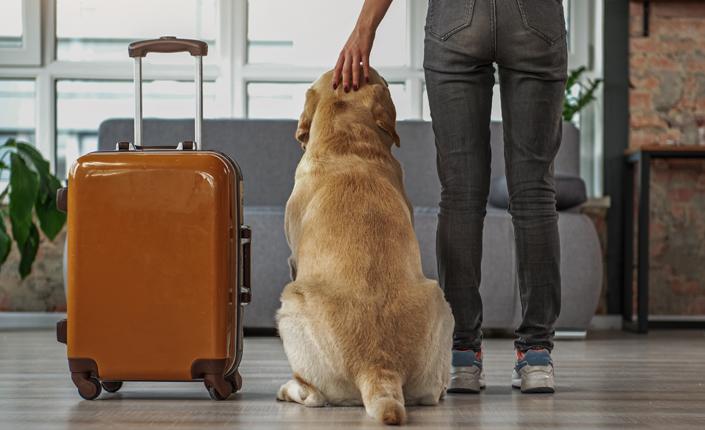
The Complete Guide to Prudent Travel With Pets
THE BASICS
- Make sure to pack an ample supply of food for your pet – about 1 ½ times as much as you expect to need for the period you’ll be away. Do not change the food immediately before or during travel – diet changes can cause gastrointestinal problems and unnecessary stress.
- If the water quality at your destination is unknown, make sure to calculate your pet’s needs when packing clean or bottled water. Contaminated or unfamiliar water can upset your stomach, and your pet’s too.
- Pack your pet’s favourite and familiar food dishes. This will help your pet feel at home and reduce territorial behaviour or resource-guarding between pets when in an unfamiliar place.
- Pets are more likely to get loose or lost when away from home. Make sure anyone can accurately identify them using a collar, tags and, most importantly, a microchip.
- Make sure you appropriately restrain your pet in your vehicle. It makes the journey safer for you and your pet. Well-secured travel crates are best, but you can also purchase seatbelt harnesses for adequate restraint.
- Call ahead to make sure that your destination is pet-friendly. Many hotels, resorts and rentals welcome pets, but require notification in advance, and may charge a small fee. Plan travel stops around pet-friendly rest areas. Never leave your pet waiting in a parked car.
- Beware of wet coats and muddy paws! Packing a towel for your pet will not only help to keep your vehicle and accommodations clean, but it will also help reduce the risk of skin and ear infections that commonly occur after being wet for prolonged periods.
- Be a considerate pet traveller. Pack poop bags, sticky lint rollers, potty pads, and any other clean-up supplies that you may need for your stay.
MEDICAL NEEDS
- Your pet’s medical needs never take a vacation. Make sure to pack all your pet’s daily and occasional medications. In case of unexpected delays, spills or loss, pack about 1 ½ times the amount you expect to need for your trip. Record the names, strengths, and dosing instructions of all medications in your smartphone, in case something goes missing.
- If you are planning an extended stay, have your veterinarian contact a clinic at your destination to make sure they can refill any prescription food or medications that you may need when you’re away.
- Take note of the location, services and hours of the veterinarian nearest to your travel destination. Know where the nearest on-call or emergency veterinarian is located. Program the necessary phone numbers into your smartphone or GPS.
- Consider creating a pet first-aid kit for travelling. Aches and pains, skin/ear infections and minor injuries frequently happen when travelling. Purchase a pet first-aid kit online, or ask your veterinarian for help assembling one.
- Make sure your pet is up-to-date with all vaccinations, deworming, and flea/tick/heartworm prevention. If you have any health concerns for your pet, make sure to book a physical examination well before leaving.
- Get a nail trim before travel, especially if you are planning beach days or hiking. Broken nails are very common!
- Make sure your pet always has access to shade and water. Insist upon adequate rest breaks. Many pets are more susceptible to heatstroke than we are. Overheating can be deadly!
- If your pet experiences anxiety or motion sickness, ask your vet to prescribe or recommend appropriate medication. Sedatives and anti-nausea meds will make the trip more comfortable for everyone, but they work best when given at least an hour before departure. If you are travelling by air, check with your airline to make sure sedatives are allowed.
INTERNATIONAL TRAVEL
- International travel for pets is very complicated. Each destination has distinct passport requirements for each pet species, and the regulations change frequently. Contact your veterinarian AND your local animal health agency (Canadian Food Inspection Agency, Department of Agriculture) 1-3 months before international travel to review the requirements. There are stringent timelines for examination, vaccination, parasite control and documentation for each destination country. Starting the process too late could mean that your pet will not be able to travel with you, could be turned away at the border, or may be subject to quarantine at the destination.
- Make sure you have an airline-approved travel crate before departure.
- Provide all required food, water and medications (plus a little extra for delays) in clearly labelled re-sealable, inspectable containers.
- Administer sedatives or anti-nausea meds at least an hour before departure.
Pets are a vital part of our families, and we want to include them in all aspects of our lives. Some pets, however, may have health needs, anxiety, or behavioural needs that make travel too stressful or dangerous for them. When planning your vacation, carefully consider if travelling is right for your pet. In some cases, for cats, in particular, an in-home pet-sitter or a boarding kennel may be the most comfortable option for your pet during your vacation. Ask your veterinarian to go over the pros and cons of travel where your animal companion is concerned.
Happy Trails!
Written by: Dr. Sperry, DVM, Veterinary Advisor, Pets Plus Us
The information provided and contained herein are the opinions of PTZ Insurance Services Ltd. which are based on external publication. The content is not intended to be a substitute for professional veterinary advice. PTZ Insurance Services Ltd. assumes no responsibility or liability for any loss, claims or damages arising out of the within content.
